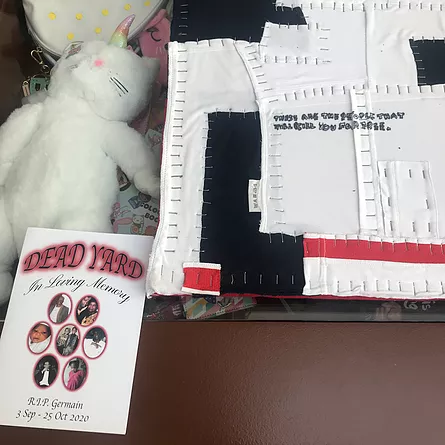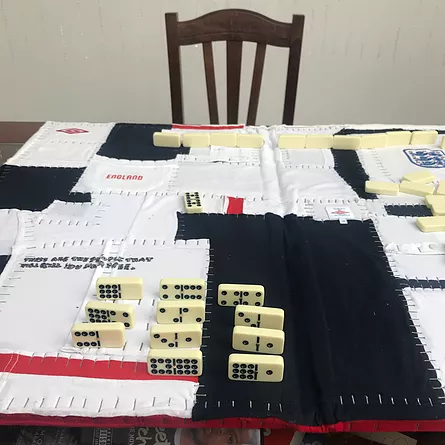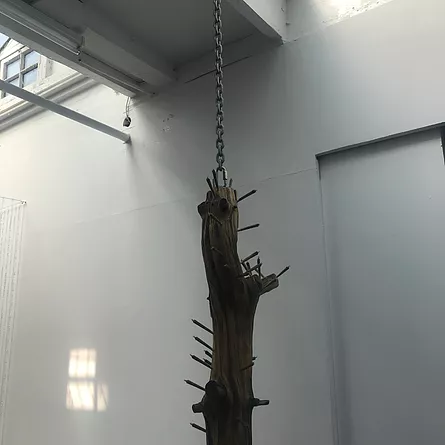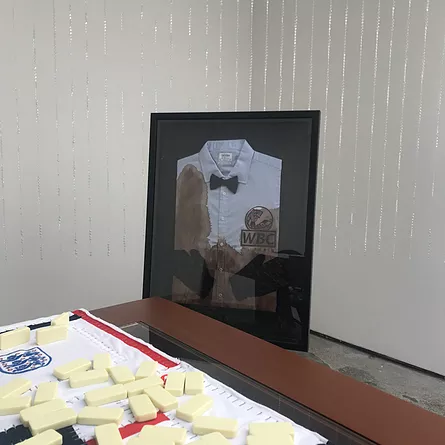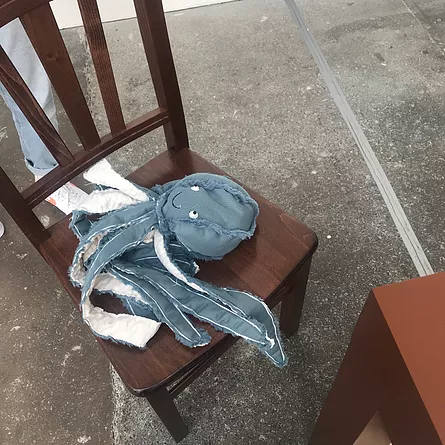Dead Yard, RIP Germain @ Cubitt
ZM
Emoji summary: 🔮 🔐 ✨
I think this makes a complete and circular kind of sense; a sense that is housed in the central body, of the gut and the heart, rather than the head. I think words are slow to follow that gut-sense, so I’m glad for this space of a twp review, where we're able to follow the central body as a logic of its own weight and value. Bear with me, this will all be speculation and conjecture. I think I’m quite taken by artworks that articulate grief, that leave space for an absence; I can’t account for why. Before this, the last show I went to see in person, back in march, was Abbas Zahedi’s <how to make a how from a why> @ South London Gallery; the last show I cried at, back last year, was Imran Perretta’s <the destructors> @ Spike Island; the last show I wrote clumsily about, that still sticks with me as an unresolved ending, loose thread and hangnail, Ima-Abasi Okon’s <Infinite Slippage> @ Chisenhale. I feel like I’m closer to rounding a corner on why these works and their articulation grip me, or why I feel them like heavy bass across my collarbones.
I went to see R.I.P. Germain’s show, <Dead Yard> at Cubitt a few weeks ago, it’s the first show Languid Hands have put on for their Curatorial Fellowship at the gallery, and it’s part of their longer programme there, called <No Real Closure>. I booked my slot, and took my mum with me; shuffled her into the gallery, nervous and excited. As you walk in, the front half of the gallery space is taken up by a lil library; rows of books, stacked on silky red fabric. The back half of the gallery is separated by a sparse beaded curtain; behind it is a glass topped vitrine table filled with objects, including a unicorn cat, makeup bag, colouring book, silk boxing shorts, DVD cases. Dining room chairs are placed specifically around it: two facing each other across the table, two diagonally across from each other. One has a framed bloody shirt propped up on it; there’s a bow tie fixed into the collar, the shirt is baby blue, the label says T.M. Lewin. The other has a little octopus toy on the seat, gormy face, arranged perfect, 8 legs askew. Flanking the beaded curtain: on the right is the body of a tree, bark stripped away, covered in resin, with joints studded into it like littler branches. There’s a heavy chain wound round the middle, and another securing it from the ceiling. It’s quiet n sculptural, strung up to stand perfectly stoic. On the left is a painted door, ragged and precarious in comparison to the tree trunk. It’s studded with lil bits of bric a brac, a rum bottle, deadbolt locks.
I didn’t realise when I booked, but the Saturday morning we visited, the artist was in the space keeping an eye on things. It was less like invigilation, more like hosting. I sat down with him for a game of dominoes at the glass topped table at the back of the gallery; he unfolded a cover made of cut up England shirts and we spoke about and around the show, the times, the moment we’re in. He told me that each work is a tribute or offering to someone he has personally lost; they are the shape of lament, loss and absence. And grief, tribute, visitation, all these points between and further. It turns out, I am crap at dominoes, I dragged the game out until we ran out of tiles. But it was a welcome moment, rare in my experience of being in galleries. My Mum & I left with the happy feeling of having been in good company; artist and artwork alike. When I drag her into galleries, she’s normally reserved and wary; puts on an Outside Voice where she doesn’t drop her consonants and barely speaks above a polite whisper. She said, ‘you know what I’m like, I don’t normally get it, but that was a nice way to go about it all’. I agreed with her, and the more I thought about it, the more I felt affirmed in my affection for this show. But I couldn’t quite articulate why; to myself or her. Now I’m writing, I think it has something to do with this wider grip that holds me, from the other shows that have affected me and my collarbones and my gut-body-sense in the past few years.
Cedric Fauq wrote about the work of 4 artists for Mousse Magazine, back in March: Carolyn Lazard, Ima-Abasi Okon, Cameron Rowland, and Abbas Zahedi. His essay winds around encounters with their work; shakes out a meaning and rumbling agreement between these artists, the conceptual relationships that are spoken through their work and varied practices. When I wrote about Ima’s show, my clumsy handling of that review fumbled around trying to articulate the way Chisenhale, as any institution, has this equal (but less visible) clumsiness when it comes to handling personhood. In my review of Imran’s film, I kinda dropped a passing remark in a similarly clumsy way; ‘I’m not convinced this work belongs in a gallery… a gallery as a site is not primed or deep-cleaned enough to house it. A gallery is an imperfect lumpy ground for it to sit in, it has jagged edges that could snag and where this film could open up a sore, a gallery doesn’t invite in the people who could act as salve.’ And in my review of Abbas’ show, I tried to break through that clumsy streak; writing through the way the work used lamentation as an unstable verb that could pierce the film between artwork, institution and audience - - - but I never quite hit at it from the right angle. I think Cedric, in his Mousse essay, gets it; in writing round those 4 artists, he identifies the terms for a departure from dealing with and relating to the institution, its systems and values and prerequisites. If the institution is a lumpy uneven ground, in need of primer or levelling; he writes that these ‘four artists use the white shell and the institution in their favor, evaluating its neutrality and employing it to better focus the attention on what they are trying to voice and recalibrate’. The 4 artists he writes around use a specific aesthetic language or conceptual sleight of hand to puncture these inflated neoliberal mechanisms that are tied to a deep-seeded anti-blackness; labour, value, exchange or transaction, god knows how the world works in its vast machinery - I stg am alienated from it all, beyond even understanding. He builds to identify a fundamental tension underneath it all; ‘these strategies also make obvious the impossibility for blackness to occupy the white gallery space. Rather, they point out to antiblackness as a pre-existing condition for these spaces to exist, so naturally blackness would rather undo and desert them, in an effort to imagine another world, in an effort to unworld the institution and institutionality.’ I think that’s it - the reason my writing round it was so clumsy was bc it sits beyond the limits of my agency and experience. There is a way to deal with being in, and commanding a departure from the institution, and all its soggy baggage, that I long for and look for, that I haven’t been able to identify, that has been rumbling away in me, and these artists, and these works, and Us. I haven’t been able to put it in to words bc those words are not for me to formalise. I am glad to feel them solid against my face though, because I think I felt something parallel; a ghost and a visitation.
In and amongst the grief and absences and refusals of all these shows, and all these works, where others are presenting absences to the institution and its audiences; <Dead Yard> held space, acted as testament or witness, Did and UnDid. It contains these points of departure and contention, as actions and possibilities; it sincerely, uncynically ruptures the perimeter that holds them. What if a gallery was capable of holding space for refusal or absence; turned-face towards a new centre of meaning by folding to that absence as a point of beginning, rather than work or concept or end point? What then, what conditions could make that possible? As movement, attempt, or action, what does that literally require? What if recalibration happens at the point of curation, what is possible within this stupid little category of art-making? <Dead Yard> presents us with a softer grief, pushes us away from the requirement of understanding it by embracing us into itself; it does so while also setting itself as total. If we must mourn, then let us mourn aloud, let us mourn together, uninterrupted. Where others burst and ruptured, R.I.P. Germain taps a leak; I am carried away by it all the same, but this time I float.
<Dead Yard> is on at Cubitt Gallery until 25th October, book to see it here. This show, by R.I.P. Germain, is the first show of <No Real Closure>, a programme of 5 commissions curated by Languid Hands, as part of their Curatorial Fellowship at the gallery.
